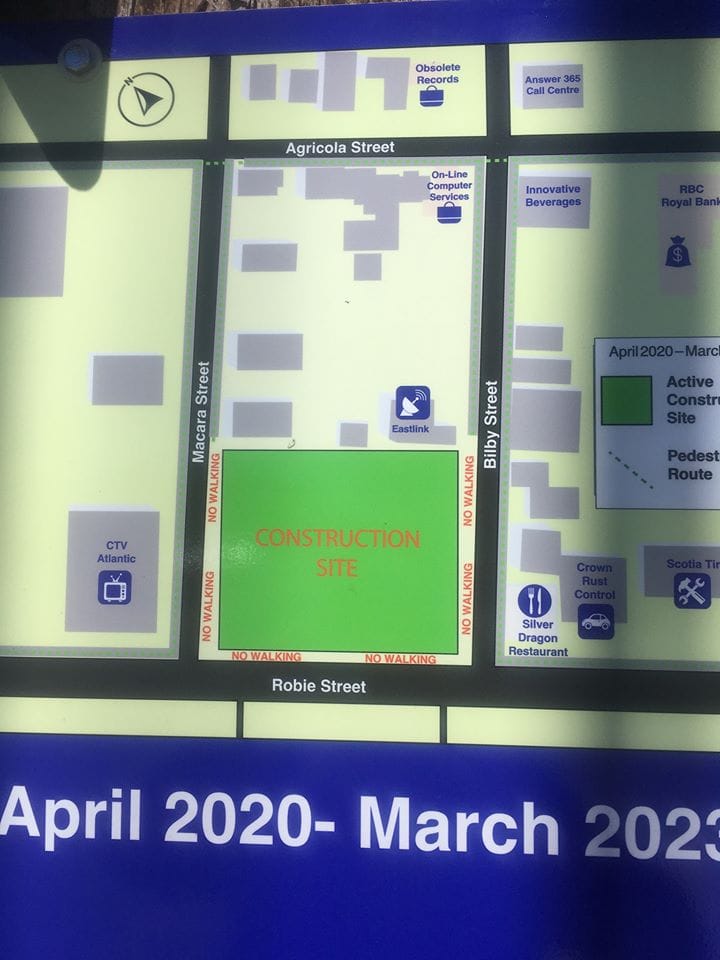
Dear Mr Anguish, Councillors Nichol and Smith, also any other relevant staff and councillors.
I am extremely concerned to see that despite a recent update to our construction site management guidelines, severe issues continue with the implementation of appropriate measures that afford safe passage to pedestrians and prevent extremely lengthy and impractical detours for those on foot.
I understand that a sidewalk will be closed on Robie Street between Macara and Bilby Street for three years. The marked alternative route of approximately 370 metres in distance seems to require pedestrians to detour via Agricola Street. This is an extremely lengthy journey for someone on foot, and completely impossible for many categories of people including the elderly or disabled, who rely on short journeys for practical necessities.
Pedestrians include many people who are not young, fit and able. Particularly without rest stops (such as benches), they may be unable to complete this distance and so would either be required to take a risky short-cut across Robie, or would be unable to make the journey at all.
An alternative detour would be to use the unmarked crosswalks over Robie Street at the intersections of Macara or Bilby Streets. At this point without traffic control measures, such a crossing over five traffic lanes would be extremely treacherous.
The only other possible route would be to use the signalized intersection crosswalks at Almon/Robie and Young/Robie. These crosswalks are four hundred metres apart, requiring a detour of nearly one kilometre if access is required to the North side of Robie Street. Signalized crosswalks are currently also not safe for people of all ages and abilities due to the deliberately programmed signal conflicts between vehicles and pedestrians (and right on red laws), as demonstrated by extensive local incident data.
Due to the lack of safe points to cross the road and the unrealistic and impractical length of this detour, an alternative must be considered. Fortunately at this point due to the ample five lanes for traffic, a lane can be closed off and reallocated to pedestrians for use.
This must be prioritised for implementation immediately, given:
- The current detours are not suitable for all ages and abilities, especially given this 370 metre re-route is presumably intended to be in place for three years.
- Given this, pedestrians are likely to take a risk by crossing the five lanes of traffic using the unmarked legal crosswalks.
- Engineers may be aware that this road is effectively a highway by design (a four hundred metre straight stretch of uninterrupted multiple traffic lanes), therefore high driver speeds of over 50kph will be the result.
- Such traffic speeds are not safe to combine with the pedestrian rights of way at unmarked crosswalks.
- Unfortunately older pedestrians are most at risk by this arrangement, and they are also the most likely victims of traffic fatalities in HRM. Two senior pedestrians have died on dangerous marked crosswalks over multiple-lane roads so far this year. In both cases, they were attempting to cross legally.
- North American Traffic Authority guidance suggests accommodation for pedestrians in temporary traffic control zones should “ensure that temporary routes are not much longer than the original route”.
The issues arising relating to our policies and approach to pedestrian safety are as follows:
Include road diets in our traffic calming policy to improve safety and promote transport diversity
Where there is a legal right of way for pedestrians over a treacherous urban highway, they should be given the choice to exercise that right without the need to risk their life.
That right should not be removed through a choice of only accommodating the needs of motorised traffic to move quickly and efficiently. This issue can be assessed and addressed through a combination of known safety measures.
A road diet would slow traffic speeds and adapt roads like Robie so they can become safe for all road users. Appropriate countermeasures would pay for themselves due to the reduced need to police constant high speeds, and the reduced costs arising from the many pedestrians who are hit along this stretch of road.
This excellent video from the US Department of Transport demonstrates how road diets work; using pedestrian refuge islands, cycle or bus lanes and potentially raised crosswalks.
As discussed in person with Councillor Nichol, like Ottawa’s amended comprehensive traffic calming policy, we need to adapt our traffic calming policy to include appropriate road diet adaptations for our many dangerous urban highways, as part of our toolkit to effect road safety where it’s needed the most.
Road diets have the additional benefit of promoting transport diversity, so reducing congestion.
Our construction site management guidelines must account for human limitations and diversity
Despite our construction site management guidelines being recently reviewed, they don’t seem to account for the need to assess detours and arrangements from the perspective of pedestrians of all ages and abilities, and whether a detour (as in this case) is so impractical that it is likely to result in risky behaviour.
Vision Zero is a process undertaken by the relevant authorities to assess what causes human error causing incidents. Vision Zero policies ascertain and address the root causes of error with appropriate infrastructure and control measures.
As we have adopted Vision Zero as a policy, there is a need to include this assessment and make it central to the decision-making process, to ensure pedestrian detours are both safe and likely to be chosen by pedestrians.
There is also a need to consider whether any detour is practical for people of all ages and abilities in light of our accessibility and human rights legislation. A detour which is lengthy or unsafe will not be suitable for protected and most disadvantaged categories of people, including the elderly and disabled. Neither will it meet any policy or efforts by governance to make sure people on foot are prioritised in our transportation network and decision making.
Please could our construction site management guidelines be reviewed to ensure they place the needs of people first, and ensure those who are most in need of consideration and priority are given that, always.
Re-evaluate existing plans to ensure they meet Vision Zero policy, and NACTO recommendations
Waye Mason recently assured the public that pedestrian safety is “baked into” new projects:
“I’ve been saying for years that every paving project on every road, path and sidewalk is a pedestrian safety project. They all need to meet those new standards!”
This is an extremely good aim, however it is clear from the redesign plans for this section of road (approved on 16 July 2019) that it is not being met – see page 182.
The unmarked legal crosswalks along this stretch of Robie between Young and Almon Street have not been considered and will remain unmarked and not crossable, leaving marked crosswalks 400m (1300 feet) apart at the two very wide signalized intersections. This is nearly seven times the maximum NACTO recommended spacing between marked crosswalks. A more pedestrian friendly centre median bus lane option which included an additional crosswalk was not selected by leadership.
Neglecting to provide appropriately spaced crosswalks will increase vehicle speeds and “cause pedestrians to cross along a more direct, but unsafe or unprotected route”. Without appropriately spaced and safe marked crosswalks, this road will not be fit or safe for pedestrians.
Unsafe and impractical detours due to sidewalk closures is an issue which causes pedestrians frequent concern and difficulty. I’m also concerned that without a robust planning and decision-making procedure, such as using a checklist of essential NACTO and Vision Zero criteria, we are not in fact improving pedestrian safety or mobility.
This email is intended to be constructive and to assist everyone to meet the needs of pedestrians better, and I trust it will be construed that way. I would be grateful to receive a response on the requests and issues I have made above so I can feed this back to others.
With best wishes
Martyn Williams
If you walk, cycle or use a wheelchair and are affected by road safety issues, please join HRM Safe Streets for Everyone. If your local crosswalk needs a crosswalk flag, please contact the Crosswalk Safety Society. Please remember to report issues affecting your safety to our municipal authorities using the 311 service.
With a special thanks to our generous donors who make publication of the Nova Scotia Advocate possible.
Subscribe to the Nova Scotia Advocate weekly digest and never miss an article again. It’s free!



